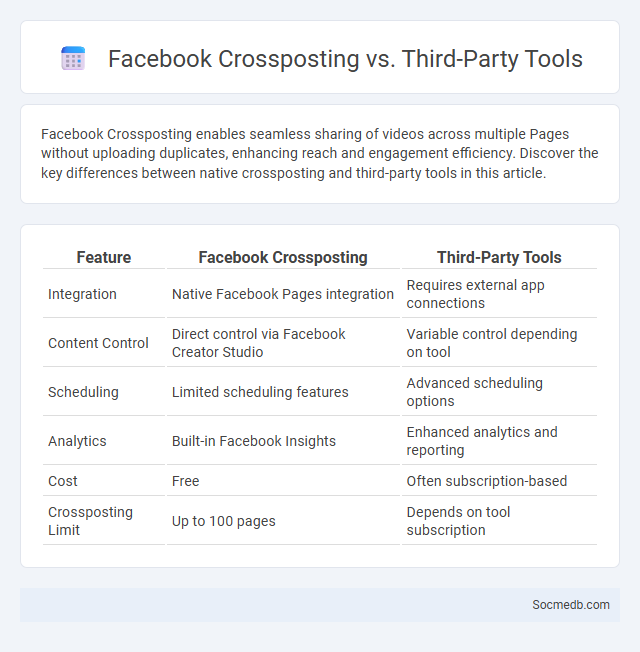
Photo illustration: Facebook Crossposting vs Third-Party Tools
Facebook Crossposting enables seamless sharing of videos across multiple Pages without uploading duplicates, enhancing reach and engagement efficiency. Discover the key differences between native crossposting and third-party tools in this article.
Table of Comparison
| Feature | Facebook Crossposting | Third-Party Tools |
|---|---|---|
| Integration | Native Facebook Pages integration | Requires external app connections |
| Content Control | Direct control via Facebook Creator Studio | Variable control depending on tool |
| Scheduling | Limited scheduling features | Advanced scheduling options |
| Analytics | Built-in Facebook Insights | Enhanced analytics and reporting |
| Cost | Free | Often subscription-based |
| Crossposting Limit | Up to 100 pages | Depends on tool subscription |
Understanding Facebook Crossposting
Facebook crossposting allows you to share videos across multiple Pages without uploading duplicates, maximizing your content's reach and engagement efficiently. By linking your Facebook Pages, you can publish a single video once and post it simultaneously to all connected Pages, preserving video insights and boost options. This feature helps you streamline content management and maintain consistent branding across your social media channels.
What Are Third-Party Crossposting Tools?
Third-party crossposting tools enable users to publish the same content simultaneously across multiple social media platforms, enhancing reach and engagement. These tools support various networks like Instagram, Facebook, Twitter, and LinkedIn, streamlining content management and scheduling workflows. By automating crossposting, brands and influencers save time while maintaining consistent messaging across diverse audiences.
Key Differences Between Facebook Native Crossposting and Tools
Facebook native crossposting enables seamless content sharing between Pages, preserving video quality and engagement metrics, while third-party tools often lead to reduced video resolution and fragmented audience analytics. Native crossposting supports direct rights management and automatic audience targeting, which external tools may lack, limiting promotional effectiveness. Integration with Facebook's algorithm through native crossposting enhances organic reach and discoverability compared to the often generic deployment of posts via crossposting tools.
Pros and Cons of Facebook Crossposting
Facebook crossposting allows you to share videos across multiple pages without re-uploading, increasing reach and engagement efficiently. It simplifies content management and boosts visibility but may cause inconsistent audience targeting and reduced personalization. Your brand's messaging needs careful handling to avoid dilution when using crossposting across diverse page audiences.
Pros and Cons of Third-Party Crossposting Tools
Third-party crossposting tools streamline content distribution across multiple social media platforms, enhancing efficiency and ensuring consistent brand messaging. These tools provide valuable analytics and scheduling features but may pose security risks due to access permissions and increase dependency on external services. Users must balance the productivity benefits with potential data privacy concerns and occasional API limitations from different social media platforms.
Crossposting: Best Practices and Guidelines
Crossposting on social media maximizes Your content reach by sharing posts across multiple platforms while maintaining platform-specific customization for optimal engagement. Use consistent branding, tailor captions for each audience, and post during peak activity times to increase visibility and interaction. Monitor analytics closely to refine Your crossposting strategy and ensure content resonates with viewers on each distinct channel.
Performance Comparison: Native vs. Third-Party Crossposting
Native social media posting offers superior platform integration and real-time analytics, enhancing your content visibility and engagement rates compared to third-party crossposting. Third-party tools often experience delays and reduced algorithm favorability, which can diminish organic reach and performance metrics. Choosing native posting ensures optimized audience targeting and maximized ROI on your social media campaigns.
Workflow Efficiency: Which Method Saves More Time?
Utilizing automation tools and integrated platforms in social media management significantly enhances workflow efficiency by scheduling posts, analyzing engagement, and streamlining content creation processes. Comparing manual posting methods with automation reveals that scheduling tools like Hootsuite or Buffer can save up to 60% of time typically spent on daily updates. Efficient workflow in social media management directly translates to faster campaign execution and consistent audience engagement, driving better ROI for marketing teams.
Choosing the Best Crossposting Method for Your Needs
Selecting the optimal crossposting method depends on the specific goals, platforms involved, and content type. Manual crossposting allows for tailored content but requires more time, while automated tools enhance efficiency and consistency across channels like Instagram, Facebook, and Twitter. Evaluating factors such as audience engagement patterns, scheduling flexibility, and analytics integration ensures the best alignment with your social media strategy.
Final Verdict: Facebook Crossposting or Third-Party Tools?
Facebook Crossposting offers seamless content sharing across multiple pages within the same Business Manager, enhancing organic reach and engagement through native platform support. Third-party tools like Hootsuite and Buffer provide advanced scheduling, analytics, and multi-platform management, ideal for diverse social media strategies requiring broader oversight. Your choice depends on whether you need integrated Facebook features or comprehensive multi-channel control for optimized social media marketing.
 socmedb.com
socmedb.com